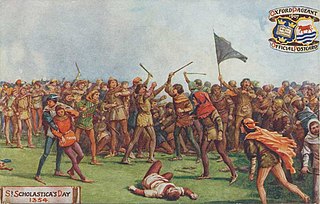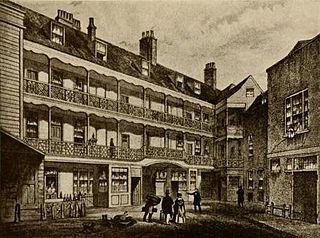
A pub is an establishment licensed to serve alcoholic drinks for consumption on the premises. The term public house first appeared in the late 17th century, and was used to differentiate private houses from those which were, quite literally, open to the public as 'alehouses', 'taverns' and 'inns'. By Georgian times it had become common parlance, although taverns, as a distinct establishment, had largely ceased to exist by the beginning of the 19th century. Today, pubs have no strict definition, but CAMRA states a pub has four characteristics:
- is open to the public without membership or residency
- serves draught beer or cider without requiring food be consumed
- has at least one indoor area not laid out for meals
- allows drinks to be bought at a bar

Fleet Street is a major street mostly in the City of London. It runs west to east from Temple Bar at the boundary with the City of Westminster to Ludgate Circus at the site of the London Wall and the River Fleet from which the street was named.

The Angel, Islington, is a historic landmark and a series of buildings that have stood on the corner of Islington High Street and Pentonville Road in Islington, London, England. The land originally belonged to the Clerkenwell Priory and has had various properties built on it since the 16th century. An inn on the site was called the "Angel Inn" by 1614, and the crossing became generally known as "the Angel". The site was bisected by the New Road, which opened in 1756, and properties on the site have been rebuilt several times up to the 20th century. The corner site gave its name to Angel tube station, opened in 1901, and the surrounding Angel area of London.

The coaching inn was a vital part of Europe's inland transport infrastructure until the development of the railway, providing a resting point (layover) for people and horses. The inn served the needs of travellers, for food, drink, and rest. The attached stables, staffed by hostlers, cared for the horses, including changing a tired team for a fresh one. Coaching inns were used by private travellers in their coaches, the public riding stagecoaches between one town and another, and the mail coach. Just as with roadhouses in other countries, although many survive, and some still offer overnight accommodation, in general coaching inns have lost their original function and now operate as ordinary pubs.

Pub names are used to identify and differentiate traditional drinking establishments. Many pubs are centuries old, and were named at a time when most of their customers were illiterate, but could recognise pub signs. The use of signage was not confined to drinking establishments. British pubs may be named after and depict anything from everyday objects, to sovereigns, aristocrats and landowners. Other names come from historic events, livery companies, occupations, sports, and craftsmen's guilds. One of the most common pub names is the Red Lion.

The St Scholastica Day riot took place in Oxford, England, on 10 February 1355, Saint Scholastica's Day. The disturbance began when two students from the University of Oxford complained about the quality of wine served to them in the Swindlestock Tavern, which stood on Carfax, in the centre of the town. The students quarrelled with the taverner; the argument quickly escalated to blows. The inn's customers joined in on both sides, and the resulting melee turned into a riot. The violence started by the bar brawl continued over three days, with armed gangs coming in from the countryside to assist the townspeople. University halls and students' accommodation were raided and the inhabitants murdered; there were some reports of clerics being scalped. Around 30 townsfolk were killed, as were up to 63 members of the university.

Punch Pubs & Co is a pub and bar operator in the United Kingdom, with around 1,300 leased pubs. It is headquartered in the traditional brewing centre of Burton upon Trent in Staffordshire. It was listed on the London Stock Exchange as a constituent of the FTSE SmallCap Index until its sale in 2016 for £403m to a private equity fund, Patron Capital, acting in concert with Heineken International who acquired 1,900 of Punch's pubs as part of the deal.

Alfred Street is a street running between the High Street to the north and the junction with Blue Boar Street and Bear Lane at the southern end, in central Oxford, England. To the south is Christ Church, one of Oxford University's historic colleges.

Blue Boar Street is a narrow historic street running between St Aldate's to the west and the southern end of Alfred Street to the east, in central Oxford, England. It is located just north of Christ Church.

Bear Lane is a short historic street in central Oxford, England. The lane is located just north of Christ Church. It runs between the junction of Blue Boar Street and Alfred Street to the west, and King Edward Street and the north of Oriel Square to the east.

Barford St Michael is a village on the south bank of the River Swere in Oxfordshire, England, about 5 miles (8 km) south of Banbury.

In the historical era of English Renaissance drama, an Inn-yard theatre or Inn-theatre was a common inn with an inner courtyard with balconies that provided a venue for the presentation of stage plays.

The Boar's Head Inn is the name of several former and current taverns in London, most famously a tavern in Eastcheap that is supposedly the meeting place of Sir John Falstaff, Prince Hal and other characters in Shakespeare's Henry IV plays. An earlier tavern in Southwark used the same name, and an inn of the name in Whitechapel was used as a theatre.

The Old White Horse Cellar also known as Hatchetts White Horse Cellar at No. 155 Piccadilly, was one of the best known coaching inns in England during the 18th and 19th centuries. The first mention of the White Horse Cellar is in 1720. It was originally located on the corner of Arlington Street, where the Ritz Hotel is now located. The first landlord, a man named Williams, named it in honor of the newly established House of Hanover, whose heraldic emblem featured a white horse. The White Horse rose to prominence under Abraham Hatchett who later moved it to the opposite side of the road on the corner of Albemarle Street, where it was known as "Hatchett’s Hotel and White Horse Cellar". The precise date of the move is not known, but was precipitated by the construction of the Bath Hotel, which was located on the corner of Piccadilly and Arlington as early as 1798. It was torn down in 1884 to make room for the Albemarle.

The Mitre Inn is a public house at 58 High Street, Chipping Barnet, London. It was established by 1633 and is probably the oldest remaining of the town's once numerous coaching inns. It is a grade II listed building with Historic England and is currently styled "Ye Olde Mitre Inne".

The Boar's Head Inn was a tavern in Eastcheap in the City of London which is supposed to be the meeting place of Sir John Falstaff, Prince Hal and other characters in Shakespeare's Henry IV plays.

The Edgar Wallace is a public house at 40–41 Essex Street, London WC2, at the corner with Devereux Court.





















